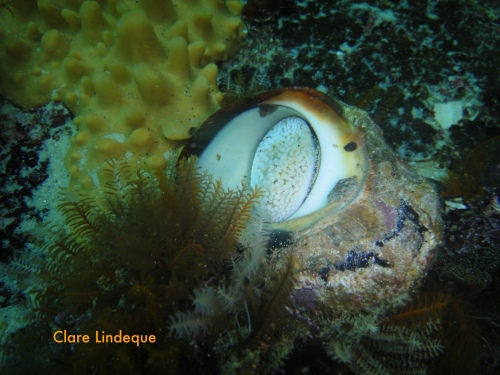Alikreukel (Turbo sarmaticus) or giant periwinkles are also called ollycrocks, cockles or turban shells. Unfortunately if you google them you will mostly come up with recipes on how to cook them rather than their natural history! Like abalone, alikreukel are a slow-growing, heavily exploited food source and very large specimens are rare outside of marine reserves.
These large underwater snails can close their shells using a trapdoor called an operculum. One side is smooth, brown and spiralled, and the other (seen above) is covered in little white knobs. Their shells are unassuming when they are alive, but can be polished to show off the beautiful mother of pearl underneath the outer layers when empty. The snails’ bodies have a dark black or brown lip, with the rest being orange (as can be seen in the photo below).
Alikreukel are broadcast spawners, which means that males and females release their gametes and sperm into the water column in a synchronised effort. The fertilised eggs go through a larval stage, free floating until they start to develop a shell. Alikreukel are found to a depth of only about eight metres and use their rasping tongue, called a radula to feed on seaweed and algae.




[…] (but lots of shells) – I think they’ve been poached out. The place is crawling with alikreukel. Fortunately at Photographer’s Reef, a 400 metre swim directly out into the bay from […]
By: Dive sites: Windmill Beach « Learn to Dive Today on 3 November 2011
at 0731